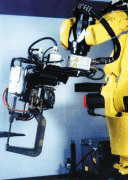|
Republished with Permission from Automotive Manufacturing & Production magazine - copyright January 2000.
A robotic tool changer from ATI Industrial Automation (Apex, NC) has been launched that is specially designed for transgun resistance welding operations—not only for the performance of the welding tasks, but for facilitating the required maintenance that is often time-consuming, and therefore which decreases overall productivity.
A typical routine in dealing with robotic tool changers with high-power contacts is to:
(a)
Disassemble the high-power components
(b)
Disconnect cables
(c)
Remove and replace contacts
(d)
Reassemble the changer.

|
|
A robot tool changer designed for ease of maintenance and reliable performance.
|
This is not only time-consuming, but it is labor-intensive and expensive, too. So the SW-150A tool changer was designed and engineered to help ameliorate these vexing maintenance issues.
Essentially, there is a master plate that is attached to the robot with an interface plate. The tool plate is then attached to the master plate. The attachment of the master plate and the tool plate is done via an air-actuated mechanism that's made with 440 stainless steel hardened to Rc58. The patented ball-locking device keeps the two plates together with more than 3,600 lb. of clamping force. (Should there be a sudden loss of air pressure, there is a fail-safe mechanism that keeps the plates together.) The spot welding gun is attached to the tool plate.
The SW-150A has a payload capacity of 440 lb.
Fundamentally, the problem that the design of the new tool changer addresses is that of electrical contact contamination. One of the problems that arises in welding operations is that when flat contacts are not connected to their mating assemblies there is the possibility that they can become contaminated (with welding slag, for example). Then, when they are put back in use, the contacts tend to fail via one failure mode or another (e.g., overheating, arcing, pitting).
What ATI engineers have done is to forego the use of flat contacts and to use male- and female-shaped contacts. The contact ratings are 200 amp, 25% duty cycle, 660-v. The male contact is mounted on the tool assembly and the female on the tool changer master assembly. The conical contacts are plated with rhodium, a hard, high-conductivity material with a high melting temperature. The benefit of using rhodium: welding slag is not as likely to cause problems as is ordinarily the case.
The contacts on the SW-150A are designed so that they can be removed and replaced by using a hex wrench while the master plate is still connected to the robot and the tool plate is attached to the gun. According to ATI, a change can be made in minutes because of this design. Heretofore, it may have required hours.
Another module for the tool changer is the fluid/air module. Once again, a goal here is easy maintenance. For example, if the fluid port becomes clogged, then the port can be taken apart with a socket hex wrench. Clean it out, and put it back together (it can be done in two minutes or less), and you're back in business.
Another feature of this module is the manifold that's coated with a material called Zicor; the benefit here is that Zicor doesn't strip away in high pH water as anodized material can. The module features seal-sealing air and fluid ports, and a low-friction seal that prevents sticking of the valve seal so that when the master disconnects from the tool, there's rapid sealing.
The fluid module keeps abundant water flowing to keep the gun and the transformer cool. The measurement of flow is coefficient of volume (Cv), which is the number of gallons per minute that flow through a port with a 1.0-psi pressure drop. The Cv for the SW-140A is 1.7.
Finally, there's the signal module, which can be fitted with a tool ID option that allow users to select from one to eight tools. The signal module is also produced to be robust. For example, the electrical spring pin contacts on both the master and tool plates are also plated with rhodium, which has better performance than gold or silver.—GSV
|